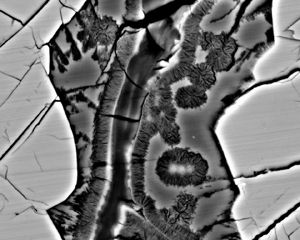
In 1911 a meteorite from Mars hurtled towards North Africa, splitting into forty small pieces, and (legend has it) killing a dog. Harriet Jarlett reports.
Geoscientist Online 23 February 2011
Exactly a century after the first nakhlite meteorite was discovered in El-Nakhla, Egypt, the same meteorite is being used to discover how water may have flowed on Martian surfaces
1. (together with other samples from Lafayette, Yamoto and Governador Valadares meteorites).
The Nakhla meteorite is a rare type of meteorite, being a sample of the planet Mars that was splashed off the surface of the Red Planet by another meteorite impact. Mars, having a much lower gravitational pull than the Earth, requires a much smaller impact to force ejecta out of its gravity well, and into interplanetary space. Some of these escaped ejecta then find their way towards the Earth.
Scientists from the University of Leicester’s Space Research Centre milled micron-thin slices off the martian meteorite fragments and examined them under the electron microscope in an attempt to understand the hydrothermal processes which formed the secondary minerals infilling some prominent veins.
The veins formed when a brine flowed through the rock (a lava) while it was still part of its parent planet. These veins were already known to have contained ice, carbonate and clay minerals in amounts corresponding to their depth below martian surface (the shallower meteorites contain soluble salts)
2, which formed during the impact that sent them hurtling towards the Earth.
Changela and Bridges suggest the fluid came from an underground source, such as permafrost; and since deeper nakhlites, like Lafayette, show greater amounts of alteration Changela and Bridges realised that the water had not percolated downwards from the planet surface but instead flowed upward, like water rising from an aquifer to a source spring.
Changela suggests that an impact shock caused the minerals to fracture, and the subsurface permafrost to melt and flow through nearby rock. Dr Bridges, who is supervisor to Hitesh Changela’s PhD, explains the importance of this discovery: “We are now starting to build a realistic model for how water-deposited minerals formed on Mars, showing that impact heating was an important process.”
Bridges and Changela have been able to identify what size of impact would be needed to form such a hydrothermal system, and can match this to the age and hemisphere in which the nakhlites were born. They have then been able to model how much fluid was likely to have been formed, and how long the system lasted for (one to 10 months).
This discovery comes soon after Mars orbiters revealed carbonate and phyllosilicates on the surface of the planet, such as those found in the Nili Fossae region, where surface fluvial activity and shallow lake deposits may have resulted in carbonate formation
3. Clay minerals identified in the walls of impact craters suggest local hydrothermal systems created by impacts are common to the Martian surface.
Further reading:
- Alteration assemblages in the nakhlites: Variation with depth on Mars (pp 1847–1867)H G CHANGELA and J C BRIDGES Meteoritics & Planetary Science 45, Nr 12, 1847–1867 (2011) Article first published online: 6 JAN 2011 | DOI: 10 1111/j 1945-5100 2010 01123 x
- Alteration assemblages in the Martian meteorites: Implications for near-surface processes. Bridges J C , Catling D C , Saxton J M , Swindle T D , Lyon I C , and Grady M M 2001. In: Chronology and evolution of Mars, edited by Kallenbach R , Geiss J , and Hartmann W K Kluwer: Dordrecht pp 365–392
- Hydrated silicate minerals on Mars observed by the Mars Reconnaissance Orbiter CRISM Mustard J F , Murchie S L , Pelkey S M , Ehlmann B L , Milliken R E , Grant J A , Bibring J -P , Poulet F , Bishop J , Noe Dobrea E , Roach L , Seelos F , Arvidson R E , Wiseman S , Green R , Hash C , Humm D , Malaret E , McGovern J A , Seelos K , Clancy T , Clark R , Des Marais D , Izenberg N , Knudson A , Langevin Y , Martin T , McGuire P , Morris R , Robinson M , Roush T , Smith M , Swayze G , Taylor H , Titus T , and Wolff M 2008